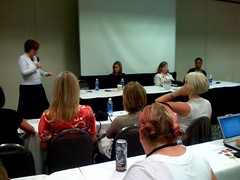On the heels of this year’s Blogher conference, I am spending a week in the Chicago area catching up with customers and family alike. (I grew up here, way back in the early Pleistocene.)

Was driving to the airport yesterday, and on the way pulled into Portillo’s for a good ol’ Chicago style hot dog. However, upon pulling into the lot, I realized that there was a line of about 10 cars in the drive-thru ahead of us. Yet, undeterred, I pulled into line. Yes, we might miss a flight, but there is research to do here!
The first thing I noticed pulling into the line was that they had turned off the automatic squawk-box ordering system, and instead had put three human beings into the line, all with headsets and walkie-talkies. As we pulled up to the first gentleman, he asked us for our order. Having not seen the menu yet, I didn’t know the answer, and said so. He deftly handed me a paper menu, and said, "No problem, just tell the next person."
We pulled up to the next person, a woman, who was about three car lengths up in the queue. She took our order, radioed it in, and handed us a claim check. (Number 87, to be precise.) We then pulled ahead to the third person, who was taking cash, wearing one of those old-style coin belts with which one can clink out coin change with ridiculous efficiency. She told us our total, took our money, made the change, and sent us rolling up to the window, where our food was already waiting.
Total time in line: MAYBE four minutes. Tops.
As we were pulling up to the cashier, I asked her if they always used this seemingly "inefficient" 3-person lineup during rush times. She said yes.
Even though it appears inefficient at first blush, the process was absolutely flawless and unbelievably fast. I would wager they do a substantially greater amount of business in their drive-thru than, say, the nearby large fast-food chain, with the standard one- or two-person drive-thru configuration.
Portillo’s website says their motto is: "The best food and the best service!" I can concur, they are two-for-two. Pass the mustard.
Related: By, the way, never, never, never order ketchup on a Chicago style hot dog, lest they say "Behold, this creature that walks like a man. It wants ketchup on its hot dog!"
image: city of buena park







